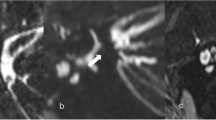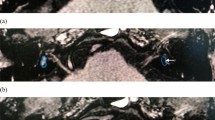Abstract
The objective of the present study was to evaluate the cochlear aqueduct (CA) in Meniere’s disease (MD) and to disclose radiological differences of CA between MD and non-MD patients by means of high-resolution computed tomography (HRCT) and high-resolution magnetic resonance imaging (HRMRI). Radiological data of 86 ears of MD patients which were separated into 52 ears of diseased side group (MD-D group) and 34 ears of contralateral non-affected side group of unilateral MD (MD-ND group), 27 ears of patients with sensorineural hearing loss (SNHL group) and 56 ears of patients with somatoform dizziness and normal hearing (control group) were analyzed retrospectively. The bony type of CA, the bony length of CA, and the bony width of CA medial orifice was measured in HRCT. The visibility of CA in HRMRI was scored. Fluid length in CA and fluid width in medial orifice were measured in HRMRI. Data were compared between MD-D, MD-ND, SNHL, and control group. There were no significant differences in the bony type of CA, bony length of CA, bony width of CA medial orifice, and fluid width of CA medial orifice between MD-D, MD-ND, SNHL and control group (p > 0.05). However, CA fluid length of MD-D (5.13 ± 1.88 mm) and of MD-ND group (5.44 ± 1.81 mm) was significantly shorter than fluid length of SNHL (6.90 ± 1.55 mm) (p < 0.001, p = 0.001) and of control group (7.43 ± 1.24 mm) (p < 0.001, p < 0.001). The ratio between CA fluid length and CA bony length was the smallest in MD-D group (0.403; p = 0.009). CA bony dimensions of affected ears of MD are normal, but CA fluid length is decreased.



Similar content being viewed by others
References
Gopen Q, Rosowski JJ, Merchant SN (1997) Anatomy of the normal human cochlear aqueduct with functional implications. Hear Res 107:9–22
Carlborg BI, Farmer JC Jr (1983) Transmission of cerebrospinal fluid pressure via the cochlear aqueduct and endolymphatic sac. Am J Otolaryngol 4:273–282
Hofman R, Segenhout JM, Albers FW, Wit HP (2005) The relationship of the round window membrane to the cochlear aqueduct shown in three-dimensional imaging. Hear Res 209:19–23
Feijen RA, Segenhout JM, Albers FW, Wit HP (2004) Cochlear aqueduct flow resistance depends on round window membrane position in guinea pigs. J Assoc Res Otolaryngol 5:404–410
Wit HP, Feijen RA, Albers FW (2003) Cochlear aqueduct flow resistance is not constant during evoked inner ear pressure change in the guinea pig. Hear Res 175:190–199
Yoda S, Cureoglu S, Shimizu S et al (2011) Round window membrane in Ménière’s disease: a human temporal bone study. Otol Neurotol 32:147–151
Stimmer H (2011) Enlargement of the cochlear aqueduct: does it exist? Eur Arch Otorhinolaryngol 268:1655–1661
Krombach GA, van den Boom M, Di Martino E et al (2005) Computed tomography of the inner ear: size of anatomical structures in the normal temporal bone and in the temporal bone of patients with Meniere’s disease. Eur Radiol 15:1505–1513
Yilmazer C, Sennaroglu L, Basaran F, Sennaroglu G (2001) Relationship of the cochlear aqueduct and inner ear pressure in Ménière’s disease and in a normal population. Otol Neurotol 22:534–538
Linn J, Peters F, Moriggl B, Naidich TP, Brückmann H, Yousry I (2009) The jugular foramen: imaging strategy and detailed anatomy at 3T. AJNR Am J Neuroradiol 30:34–41
Committee on Hearing and Equilibrium guidelines for the diagnosis and evaluation of therapy in Meniere’s disease (1995) Otolaryngol Head Neck Surg 113:181–185
Staab JP, Ruckenstein MJ (2007) Expanding the differential diagnosis of chronic dizziness. Arch Otolaryngol Head Neck Surg 133:170–176
Eckhardt-Henn A, Dieterich M (2005) Psychiatric disorders in otoneurologic patients. Neurol Clin 23:731–749
Jackler RK, Hwang PH (1993) Enlargement of the cochlear aqueduct: fact or fiction? Otolaryngol Head Neck Surg 109:14–25
Mukherji SK, Baggett HC, Alley J, Carrasco VH (1998) Enlarged cochlear aqueduct. AJNR Am J Neuroradiol 19:330–332
Migirov L, Kronenberg J (2005) Radiology of the cochlear aqueduct. Ann Otol Rhinol Laryngol 114:863–866
Davagnanam I, Chavda SV (2008) Identification of the normal jugular foramen and lower cranial nerve anatomy: contrast-enhanced 3D fast imaging employing steady-state acquisition MR imaging. AJNR Am J Neuroradiol 29:574–576
Clemia SD, Valvassori GE (1968) Recent radiographic and clinical observations on the vestibular aqueduct. Otolaryngol Clin North Am 1:339–346
Tanioka H, Zusho H, Machida T, Sasaki Y, Shirakawa T (1992) High-resolution MR imaging of the inner ear: findings in Meniere’s disease. Eur J Radiol 15:83–88
Xenellis J, Vlahos L, Papadopoulos A, Nomicos P, Papafragos K, Adamopoulos G (2000) Role of the new imaging modalities in the investigation of Meniere’s disease. Otolaryngol Head Neck Surg 123:114–119
Tanioka H, Kaga H, Zusho H, Araki T, Sasaki Y (1997) MR of the endolymphatic duct and sac: findings in Menière disease. AJNR Am J Neuroradiol 18:45–51
Salt AN, Rask-Andersen H (2004) Responses of the endolymphatic sac to perilymphatic injections and withdrawals: evidence for the presence of a one-way valve. Hear Res 191:90–100
Wit HP, Hofman R (2007) Does the endolymphatic sinus function as a one-way valve? Hear Res 224:115–116
Nakamura T, Naganawa S, Fukatsu H et al (2003) Contrast enhancement of the cochlear aqueduct in MR imaging: its frequency and clinical significance. Neuroradiology 45:626–630
Merchant SN, Adams JC, Nadol JB (2005) Pathophysiology of Ménière’s syndrome: are symptoms caused by endolymphatic hydrops? Otol Neurotol 26:74–81
Cureoglu S, Schachern PA, Paul S, Paparella MM, Singh RK (2004) Cellar changes of Reissner’s membrane in Meniere’s disease: human temporal bone study. Otolaryngol Head Neck Surg 130:113–119
Bloch SL, Friis M (2011) Objective measurement of the human endolymphatic sac dimensions in Meniere’s disease. Otol Neurotol 32:1364–1369
Shimizu S, Cureoglu S, Yoda S, Suzuki M, Paparella MM (2011) Blockage of longitudinal flow in Meniere’s disease: a human temporal bone study. Acta Otolaryngol 131:263–268
Andrews JC, Böhmer A, Hoffman LF (1991) The measurement and manipulation of intralabyrinthine pressure in endolymphatic hydrops. Laryngoscope 101:661–668
Warmerdam TJ, Schröder FH, Wit HP, Albers FW (2003) Perilymphatic and endolymphatic pressures during endolymphatic hydrops. Eur Arch Otorhinolaryngol 260:9–11
Sennaroglu L, Yilmazer C, Basaran F, Sennaroglu G, Gursel B (2001) Relationship of vestibular aqueduct and inner ear pressure in Meniere’s disease and the normal population. Laryngoscope 111:1625–1630
Mateijsen DJ, Rosingh HJ, Wit HP, Albers FW (2001) Perilymphatic pressure measurement in patients with Meniere’s disease. Eur Arch Otorhinolaryngol 258:1–4
Rosingh HJ, Wit HP, Albers FW (1996) Non-invasive perilymphatic pressure measurement in patients with Meniere’s disease. Clin Otolaryngol Allied Sci 21:335–338
Rosingh HJ, Wit HP, Sulter AM, Albers FW (1997) Longitudinal non-invasive perilymphatic pressure measurement in patients with Meniere’s disease. ORL J Otorhinolaryngol Relat Spec 59:135–140
Ayache D, Tchuente A, Plouin-Gaudon I, Vasseur J, Elbaz P (2000) Assessment of perilymphatic pressure using the MMS-10 tympanic membrane displacement analyzer (Marchbanks’ test) in patients with Meniere’s disease: preliminary report. Ann Otolaryngol Chir Cervicofac 117:183–188
Rosingh HJ, Wit HP, Albers FW (1998) Perilymphatic pressure dynamics following posture change in patients with Meniere’s disease and in normal hearing subjects. Acta Otolaryngol 118:1–5
Rosingh HJ, Albers FW, Wit HP (2000) Noninvasive perilymphatic pressure measurement in patients with Meniere’s disease and patients with idiopathic sudden sensorineural hearing loss. Am J Otolaryngol 21:641–644
De Kleine E, Mateijsen DJ, Wit HP, Albers FW (2002) Evoked otoacoustic emissions in patients with Meniere’s disease. Otol Neurotol 23:510–516
Rauch SD, Zhou G, Kujawa SG, Guinan JJ, Herrmann BS (2004) Vestibular evoked myogenic potentials show altered tuning in patients with Ménière’s disease. Otol Neurotol 25:333–338
Lin MY, Timmer FC, Oriel BS et al (2006) Vestibular evoked myogenic potentials (VEMP) can detect asymptomatic saccular hydrops. Laryngoscope 116:987–992
Kariya S, Cureoglu S, Fukushima H et al (2007) Histopathologic changes of contralateral human temporal bone in unilateral Meniere’s disease. Otol Neurotol 28:1063–1068
Kariya S, Cureoglu S, Fukushima H et al (2009) Vascular findings in the stria vascularis of patients with unilateral or bilateral Meniere’s disease: a histopathologic temporal bone study. Otol Neurotol 30:1006–1012
Seitz J, Held P, Strotzer M et al (2002) MR imaging of cranial nerve lesions using six different high-resolution T1- and T2(*)-weighted 3D and 2D sequences. Acta Radiol 43(4):329–353
Ciftci E, Anik Y, Arslan A, Akansel G, Sarisoy T, Demirci A (2004) Driven equilibrium (drive) MR imaging of the cranial nerves V-VIII: comparison with the T2-weighted 3D TSE sequence. Eur J Radiol 51(3):234–240
Conflict of interest
None.
Author information
Authors and Affiliations
Corresponding author
Additional information
J. J.-H. Park and A. Shen equally contributed to this work.
Rights and permissions
About this article
Cite this article
Park, J.JH., Shen, A., Keil, S. et al. Radiological findings of the cochlear aqueduct in patients with Meniere’s disease using high-resolution CT and high-resolution MRI. Eur Arch Otorhinolaryngol 271, 3325–3331 (2014). https://doi.org/10.1007/s00405-014-3199-8
Received:
Accepted:
Published:
Issue Date:
DOI: https://doi.org/10.1007/s00405-014-3199-8




